
- HOME
- Reggie Young Discography Project
- Travis Wammack
- Junior Lowe
- Clarence Nelson
- Willie Hightower Special Report
- Case Files
- red kelly index
- Soul Sauce
- YouTube Channel
- The Cosimo Code
- The B Side
- The A Side
- Soul Detective Blog
- Soul Sauce Archives
- Burning Questions
- Holy Ghost
- Contact us


This is the companion 'liner notes' page for the complete 1967 discography, which at last count featured over 450 playable tracks. Please check it out... then come on back here and join in the discussion and send us your comments via email Thanks!
The in-depth notes for this all-important year have been split into 'episodes' - just click on the links below:
EPISODE ONE: SHO IS GOOD
EPISODE TWO: WAYNE'S WORLD
EPISODE THREE: LET IT HAPPEN
EPISODE FOUR: CAN'T GET NO RIDE
EPISODE FIVE: A TOUCH OF THE BLUES
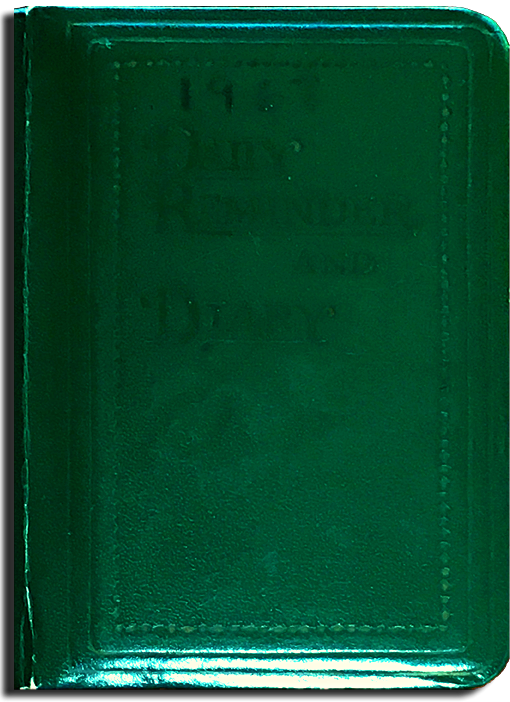 As mentioned on the discography page: "When I first started looking at the scans we made of Reggie's 1967 book, I noticed that it appeared incomplete. There was an entire month missing from May 5th to June 5th, and entries ended abruptly on September 1st. This just wasn't like Reggie, who usually kept meticulous records. I thought that perhaps we had overlooked something when we first 'digitized' the pages, but we were able to get a second look at the actual book last Summer (thank you Jenny Lynn!) and confirm that they were indeed left blank. After asking around a bit, I was able to fill in a couple of blanks from discographies and A.F.M. Union sheets, but had basically hit a dead end.
As mentioned on the discography page: "When I first started looking at the scans we made of Reggie's 1967 book, I noticed that it appeared incomplete. There was an entire month missing from May 5th to June 5th, and entries ended abruptly on September 1st. This just wasn't like Reggie, who usually kept meticulous records. I thought that perhaps we had overlooked something when we first 'digitized' the pages, but we were able to get a second look at the actual book last Summer (thank you Jenny Lynn!) and confirm that they were indeed left blank. After asking around a bit, I was able to fill in a couple of blanks from discographies and A.F.M. Union sheets, but had basically hit a dead end.
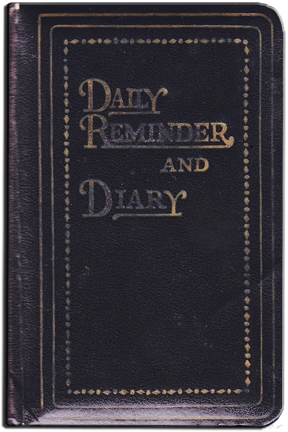 "I had been working closely with Mark Nicholson, the proprietor of the American Sound Archive, in an effort to identify what tracks were recorded when, and he reminded me that in Roben Jones' book, Memphis Boys: The Story Of American Studios, she had alluded to the fact that Bobby Emmons had also kept a similar session log book. Bobby and Reggie, of course, had been working together at Hi since 1963, and had made the decision to join Chips Moman at American around the same time. I had met Bobby's daughter Sherry a couple of times over the years, and asked her if she could locate Bobby's 1967 book. Not only did she find it, but graciously offered to send it to me so I could digitize the pages as I had done with Reggie's. This opportunity to compare and contrast the session notes from both log books has enabled us to compile the most complete and comprehensive overview of this pivotal year in the history of Memphis music yet undertaken... it almost feels as if, somewhere up there, these two inseparable friends are still calling the shots - Thank You, Sherry!!"
"I had been working closely with Mark Nicholson, the proprietor of the American Sound Archive, in an effort to identify what tracks were recorded when, and he reminded me that in Roben Jones' book, Memphis Boys: The Story Of American Studios, she had alluded to the fact that Bobby Emmons had also kept a similar session log book. Bobby and Reggie, of course, had been working together at Hi since 1963, and had made the decision to join Chips Moman at American around the same time. I had met Bobby's daughter Sherry a couple of times over the years, and asked her if she could locate Bobby's 1967 book. Not only did she find it, but graciously offered to send it to me so I could digitize the pages as I had done with Reggie's. This opportunity to compare and contrast the session notes from both log books has enabled us to compile the most complete and comprehensive overview of this pivotal year in the history of Memphis music yet undertaken... it almost feels as if, somewhere up there, these two inseparable friends are still calling the shots - Thank You, Sherry!!"
- red kelly, February 2021
![]()
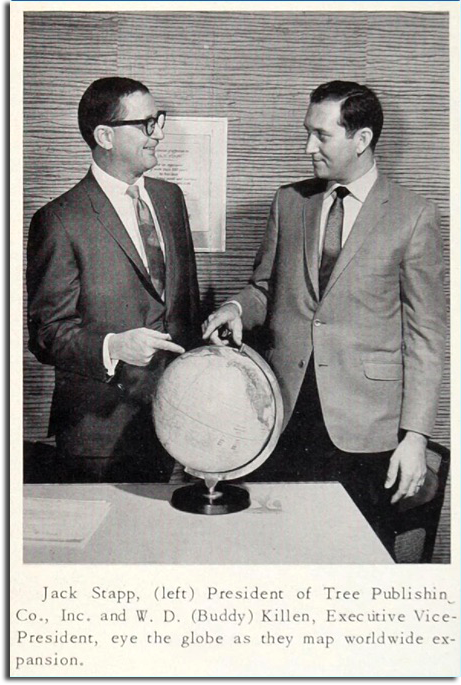 Now let's talk about another major player in this story, one W.D. 'Buddy' Killen. Killen grew up in Muscle Shoals, but left for Nashville 'before the ink was dry' on his high school diploma in 1951. working as an itinerate bass player, he was soon holding down a gig at The Grand Ole Opry and working as a session musician in the burgeoning studio scene that would become known as Music Row. Jack Stapp was the program director at legendary clear channel radio station WSM, the broadcast home of The Opry. Figuring out where the real money was in the music business, Stapp had founded his own publishing company, Tree, around the same time Buddy got to town. Stapp admired Killen's energy (and studio connections), and hired him as a 'song plugger' for the company in 1953.
Now let's talk about another major player in this story, one W.D. 'Buddy' Killen. Killen grew up in Muscle Shoals, but left for Nashville 'before the ink was dry' on his high school diploma in 1951. working as an itinerate bass player, he was soon holding down a gig at The Grand Ole Opry and working as a session musician in the burgeoning studio scene that would become known as Music Row. Jack Stapp was the program director at legendary clear channel radio station WSM, the broadcast home of The Opry. Figuring out where the real money was in the music business, Stapp had founded his own publishing company, Tree, around the same time Buddy got to town. Stapp admired Killen's energy (and studio connections), and hired him as a 'song plugger' for the company in 1953.
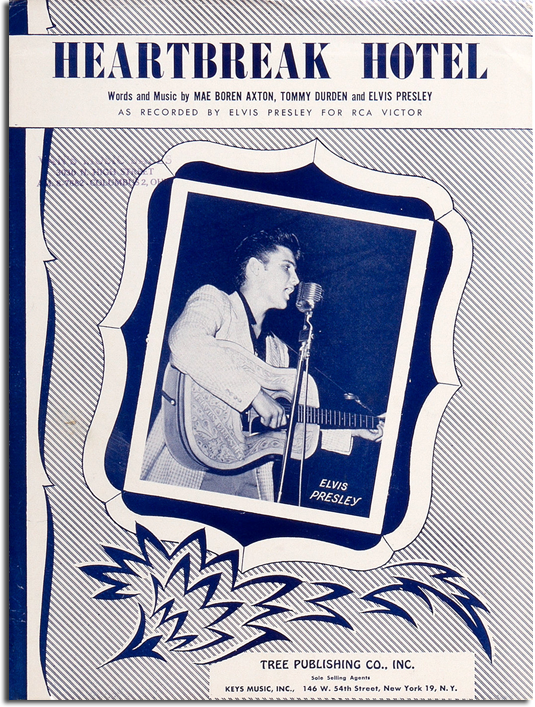 In October of 1955, Mae Boren Axton pitched a song she had written with Tommy Durden to Elvis Presley, and offered him a third of the songwriter's credit if he would record it. It remains unclear whether it was before or after he (and Col. Tom Parker) agreed, but Axton offered the publishing rights to Buddy Killen and Tree. In January of 1956, Presley and The Blue Moon Boys arrived in Nashville to record his first RCA Victor release, Heartbreak Hotel, which just blew the doors off of everything, breaking into the top five on Billboard's Pop, C&W and R&B charts on its way to becoming The King's first million seller, and putting him (and Tree) firmly on the map. In 1957, Jack Stapp would reward Buddy by naming him Vice-President and partner in the firm.
In October of 1955, Mae Boren Axton pitched a song she had written with Tommy Durden to Elvis Presley, and offered him a third of the songwriter's credit if he would record it. It remains unclear whether it was before or after he (and Col. Tom Parker) agreed, but Axton offered the publishing rights to Buddy Killen and Tree. In January of 1956, Presley and The Blue Moon Boys arrived in Nashville to record his first RCA Victor release, Heartbreak Hotel, which just blew the doors off of everything, breaking into the top five on Billboard's Pop, C&W and R&B charts on its way to becoming The King's first million seller, and putting him (and Tree) firmly on the map. In 1957, Jack Stapp would reward Buddy by naming him Vice-President and partner in the firm.
In late '57, with Elvis about to be drafted, and Colonel Parker refusing to pay them what they were worth, The Blue Moon Boys saw the handwriting on the wall and left the Elvis circus behind. They headed home to Memphis, where Scotty Moore teamed up with Slim Wallace at his Fernwood label. Prior to Moore's arrival, Wallace had been using Sam Phillips' publishing company (Knox) for his releases but, soon after Scotty's arrival, Fernwood 105 and 106 were published by Tree.
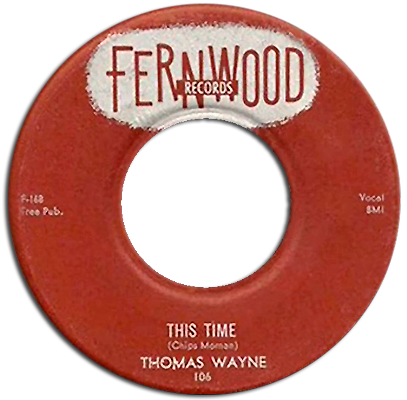 The way the story goes is that Scotty's paper boy, Tommy Wayne Perkins (brother of Tennesse Two guitarist Luther Perkins), led a vocal group at his high school, and was itching to cut a record. Dubbing him Thomas Wayne, Moore would record a couple of sides on him in early 1958. Released as Fernwood 106, Scotty was excited about the chances of the top side, Ray Scott composition "You're The One That Done It" and leased it to Mercury (71287) that March. The flip, This Time, had been
The way the story goes is that Scotty's paper boy, Tommy Wayne Perkins (brother of Tennesse Two guitarist Luther Perkins), led a vocal group at his high school, and was itching to cut a record. Dubbing him Thomas Wayne, Moore would record a couple of sides on him in early 1958. Released as Fernwood 106, Scotty was excited about the chances of the top side, Ray Scott composition "You're The One That Done It" and leased it to Mercury (71287) that March. The flip, This Time, had been 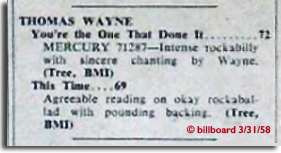 written by Wayne's guitar player, a kid named Chips Moman. Billboard agreed with Scotty, characterizing the A side as 'intense' and 'sincere,' while Moman's flip was only 'agreeable' and 'okay'... be that as it may, neither side charted and the record sank like a stone. Moore would start up his own publishing company, Bluff City Music, after that and go on to great success with Thomas Wayne a few months later when Tragedy soared to #5 on Billboard's Hot 100.
written by Wayne's guitar player, a kid named Chips Moman. Billboard agreed with Scotty, characterizing the A side as 'intense' and 'sincere,' while Moman's flip was only 'agreeable' and 'okay'... be that as it may, neither side charted and the record sank like a stone. Moore would start up his own publishing company, Bluff City Music, after that and go on to great success with Thomas Wayne a few months later when Tragedy soared to #5 on Billboard's Hot 100.
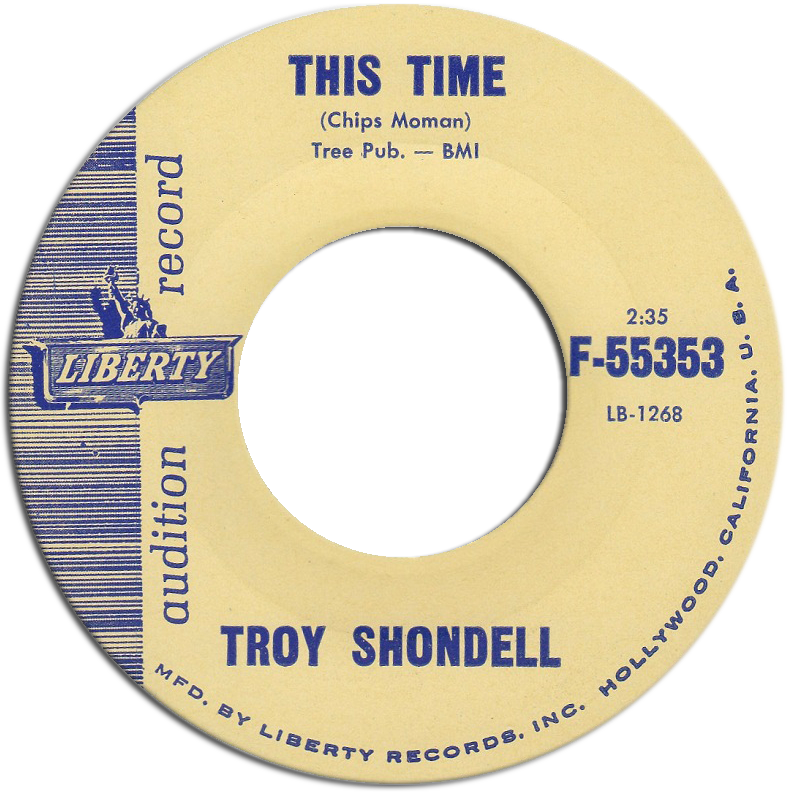 Meanwhile, a kid named Gary Shelton had had the second release on Mercury's Smash subsidiary in 1957, and been moved up to the big label (71310) around the same time as the Mercury Wayne single, with similar results. Gary must have heard something nobody else did and, after floundering around to a few other labels, he changed his name to Troy Shondell and cut This Time for the tiny Gold Crest imprint in his home town of Fort Wayne, Indiana. After being picked up for national distribution by Liberty in September of 1961, it would go on to become a smash hit, climbing to #6 on the Hot 100 and hitting #22 on the UK Singles Chart when it was released in England on London (got that?). Suddenly a top earner for Tree, Moman was now firmly on Buddy Killen's radar.
Meanwhile, a kid named Gary Shelton had had the second release on Mercury's Smash subsidiary in 1957, and been moved up to the big label (71310) around the same time as the Mercury Wayne single, with similar results. Gary must have heard something nobody else did and, after floundering around to a few other labels, he changed his name to Troy Shondell and cut This Time for the tiny Gold Crest imprint in his home town of Fort Wayne, Indiana. After being picked up for national distribution by Liberty in September of 1961, it would go on to become a smash hit, climbing to #6 on the Hot 100 and hitting #22 on the UK Singles Chart when it was released in England on London (got that?). Suddenly a top earner for Tree, Moman was now firmly on Buddy Killen's radar.
By then, Chips had been tied up with Satellite for a couple of years, and was there as the label changed its name to Stax around the same time as the Shondell record hit in late 1961. Killen, meanwhile, had created his own Dial label (distributed by London) in Nashville as an outlet for Joe Tex around then too. In the Summer of 1962, Moman would have his notorious blow-out with Stewart and Axton over money and move on. A trumpet playing lawyer named Seymour Rosenberg offered to sue Stax and wound up negotiating a settlement of $3000, which he and Chips would use to open their own studio in North Memphis literally across the street from former Blue Moon Boy Bill Black's studio, Lyn-Lou. It would be called American Sound.
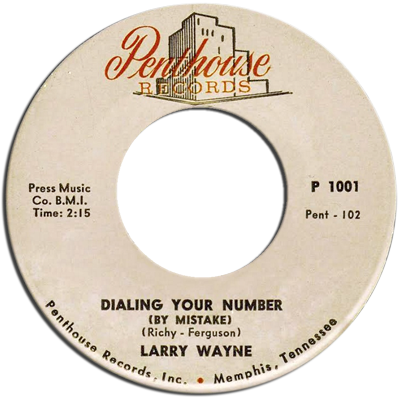
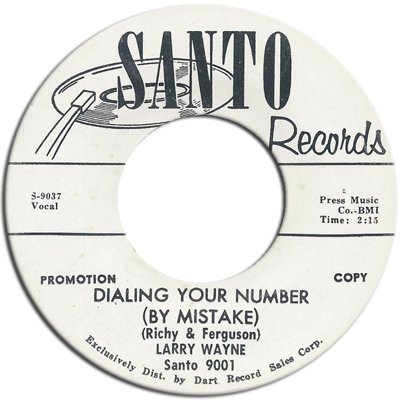 As part of the same deal, Rosenberg had set up the Penthouse label, along with a subsidiary named Youngstown and an in-house publishing company, Press Music. The first release on Penthouse would be by Chips himself, recording under the name of Larry Wayne. At this point, Rosenberg apparently offered former Dixie Rambler Wayne McGinnis a piece of the pie if he would also issue the 45 on his already established Santo label. A far cry from the groundbreaking R&B Moman had been cutting on McLemore Avenue, both sides
As part of the same deal, Rosenberg had set up the Penthouse label, along with a subsidiary named Youngstown and an in-house publishing company, Press Music. The first release on Penthouse would be by Chips himself, recording under the name of Larry Wayne. At this point, Rosenberg apparently offered former Dixie Rambler Wayne McGinnis a piece of the pie if he would also issue the 45 on his already established Santo label. A far cry from the groundbreaking R&B Moman had been cutting on McLemore Avenue, both sides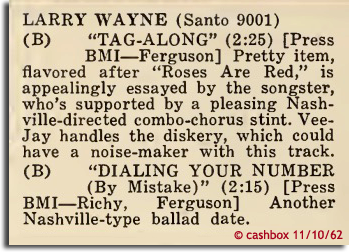 of the single had been written by former Rockabilly powerhouse Patricia Ferguson, and published by Press Music. The Nashville flavored Dialing Your Number (By Mistake) is the better of the two sides, which isn't saying much... despite a mention in Cashbox that November, the record died on the vine and apparently marked the end of Lincoln Wayne's career as a performer. By his own admission, by then Moman was "a down son of a bitch," and had gambled or drank away most of his interest in the Rosenberg American empire.
of the single had been written by former Rockabilly powerhouse Patricia Ferguson, and published by Press Music. The Nashville flavored Dialing Your Number (By Mistake) is the better of the two sides, which isn't saying much... despite a mention in Cashbox that November, the record died on the vine and apparently marked the end of Lincoln Wayne's career as a performer. By his own admission, by then Moman was "a down son of a bitch," and had gambled or drank away most of his interest in the Rosenberg American empire.
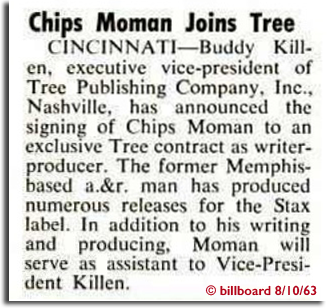 In the August 10, 1963 edition of Billboard, Buddy Killen announced that Chips Moman had been signed to an exclusive contract with Tree Publishing both as a writer and producer, and would also be serving as his personal assistant. Hmmm... Joe Tex's Dial releases had been going nowhere, and I've often wondered if Chips had anything to do with great records like I Wanna Be Free, which would be released that November. In any event, Chips' stay there in Music City appears to have been short-lived, as he was back in Memphis cutting records on Barbara & The Browns and O.V. Wright at American as early as the Spring of 1964. Shortly after that, Killen would bring Tex to Muscle Shoals to record his breakthrough hit, Hold What You've Got, which would break into the top five both R&B and Pop after Jerry Wexler convinced Buddy to switch Dial's manufacturing and distribution deal from London to Atlantic.
In the August 10, 1963 edition of Billboard, Buddy Killen announced that Chips Moman had been signed to an exclusive contract with Tree Publishing both as a writer and producer, and would also be serving as his personal assistant. Hmmm... Joe Tex's Dial releases had been going nowhere, and I've often wondered if Chips had anything to do with great records like I Wanna Be Free, which would be released that November. In any event, Chips' stay there in Music City appears to have been short-lived, as he was back in Memphis cutting records on Barbara & The Browns and O.V. Wright at American as early as the Spring of 1964. Shortly after that, Killen would bring Tex to Muscle Shoals to record his breakthrough hit, Hold What You've Got, which would break into the top five both R&B and Pop after Jerry Wexler convinced Buddy to switch Dial's manufacturing and distribution deal from London to Atlantic.
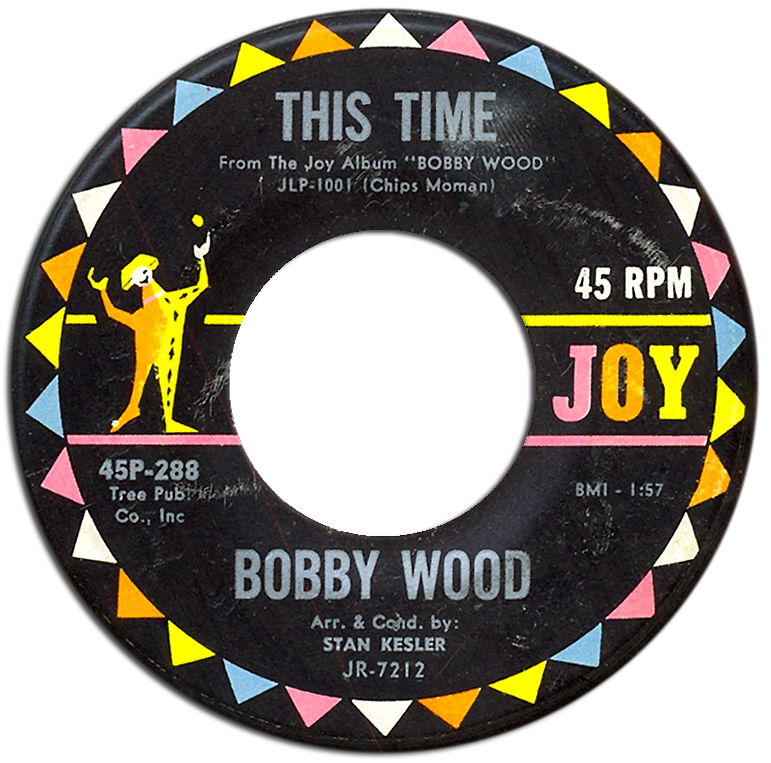 This Time was still earning Moman and Tree 'mechanicals' when it was released as the flip of future Memphis Boy Bobby Wood's #46 Country hit That's All I Need To Know in late 1964. Somewhere around in here, Don Crews bought out Rosenberg's share of American, along with that of his nephew, Wayne McGinnis. When MGM picked up the Youngstown release of The Gentrys' Keep On Dancing in 1965, Chips offered Crews a half interest in the record and leveraged himself back in as half owner of the studio, the labels and, most importantly, Press Music.
This Time was still earning Moman and Tree 'mechanicals' when it was released as the flip of future Memphis Boy Bobby Wood's #46 Country hit That's All I Need To Know in late 1964. Somewhere around in here, Don Crews bought out Rosenberg's share of American, along with that of his nephew, Wayne McGinnis. When MGM picked up the Youngstown release of The Gentrys' Keep On Dancing in 1965, Chips offered Crews a half interest in the record and leveraged himself back in as half owner of the studio, the labels and, most importantly, Press Music.
As we saw in 1966, after Jerry Wexler started using Chips Moman as his 'contractor' to import The Sound of Memphis to Fame in Muscle Shoals, Killen began doing the same thing, bringing Chips, Tommy Cogbill, Gene Chrisman and Reggie Young (remember him?) to Nashville for sessions with Bobby Marchan for Cameo/Parkway.
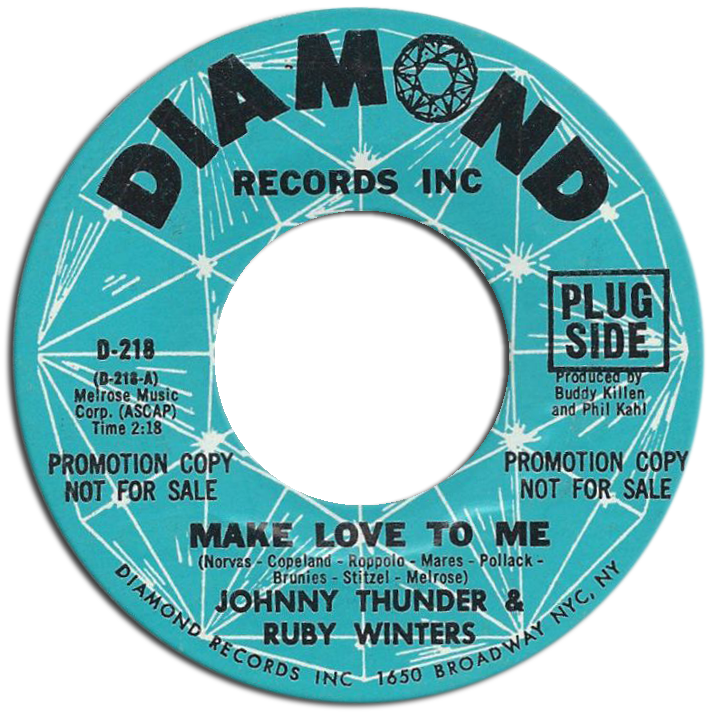 In January of '67, Buddy would import Bobby Emmons as well for a session he co-produced with New York record man Phil Kahl for Diamond Records. Initially set up to record both label veteran Johnny Thunder and recent acquisition Ruby Winters seperately, it was Kahl's brother, label head Joe Kolsky, who came up with the
In January of '67, Buddy would import Bobby Emmons as well for a session he co-produced with New York record man Phil Kahl for Diamond Records. Initially set up to record both label veteran Johnny Thunder and recent acquisition Ruby Winters seperately, it was Kahl's brother, label head Joe Kolsky, who came up with the 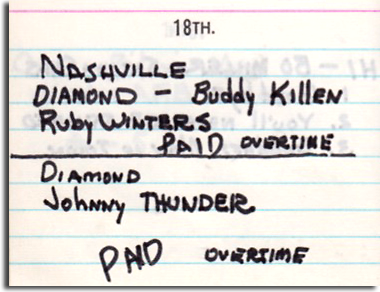 idea of cutting them as a duet. The concept worked, and Make Love To Me, propelled by Reggie's great guitar fills and Bobby's punchy organ, would spend the next two months on the charts, climbing as high as #13 R&B in Billboard. Diamond made sure they got their money's worth on the trip to Nashville, paying the musicians overtime to cut the artists individually as well, resulting in two more Diamond 45s, including Winters' blisteringly deep Try Me, with Reggie's bluesy guitar reminiscent of the work he was doing at Hi with O.V. Wright.
idea of cutting them as a duet. The concept worked, and Make Love To Me, propelled by Reggie's great guitar fills and Bobby's punchy organ, would spend the next two months on the charts, climbing as high as #13 R&B in Billboard. Diamond made sure they got their money's worth on the trip to Nashville, paying the musicians overtime to cut the artists individually as well, resulting in two more Diamond 45s, including Winters' blisteringly deep Try Me, with Reggie's bluesy guitar reminiscent of the work he was doing at Hi with O.V. Wright.
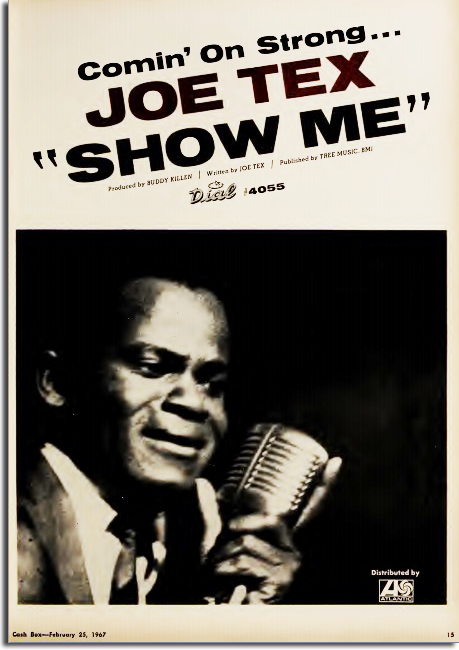 Just six days later, Killen brought Reggie back to Nashville for another marathon nine hour session on January 24th, although this time it was for his own Dial label's big star, Joe Tex. Joe had continued his chart-topping ways, with back to back #1 R&B hits as '65 gave way to '66, followed by three more that would land in the top ten, and cross over into the Pop Top 40. Buddy's confidence in Tex was finally paying off.
Just six days later, Killen brought Reggie back to Nashville for another marathon nine hour session on January 24th, although this time it was for his own Dial label's big star, Joe Tex. Joe had continued his chart-topping ways, with back to back #1 R&B hits as '65 gave way to '66, followed by three more that would land in the top ten, and cross over into the Pop Top 40. Buddy's confidence in Tex was finally paying off. 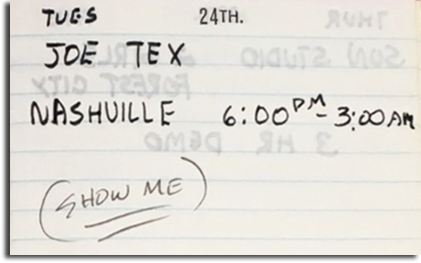 One of Joe's most enduring classics, Show Me, was cut that day, and go on to hit #35 on Billboard's Hot 100 that Spring. They just don't come much better than this y'all! Although not released until December, the great Don't Give Up (with Reggie's trademark licks all over it) was also cut at that session. Now here's something I never realized until I started researching all this... the very same day that this session was being held in Music City, Chips Moman, Dan Penn, Tommy Cogbill and Charlie Chalmers were 125 miles away in Muscle Shoals, cutting Do Right Woman, Do Right Man on Aretha for Jerry Wexler at Fame. Unreal!
One of Joe's most enduring classics, Show Me, was cut that day, and go on to hit #35 on Billboard's Hot 100 that Spring. They just don't come much better than this y'all! Although not released until December, the great Don't Give Up (with Reggie's trademark licks all over it) was also cut at that session. Now here's something I never realized until I started researching all this... the very same day that this session was being held in Music City, Chips Moman, Dan Penn, Tommy Cogbill and Charlie Chalmers were 125 miles away in Muscle Shoals, cutting Do Right Woman, Do Right Man on Aretha for Jerry Wexler at Fame. Unreal!
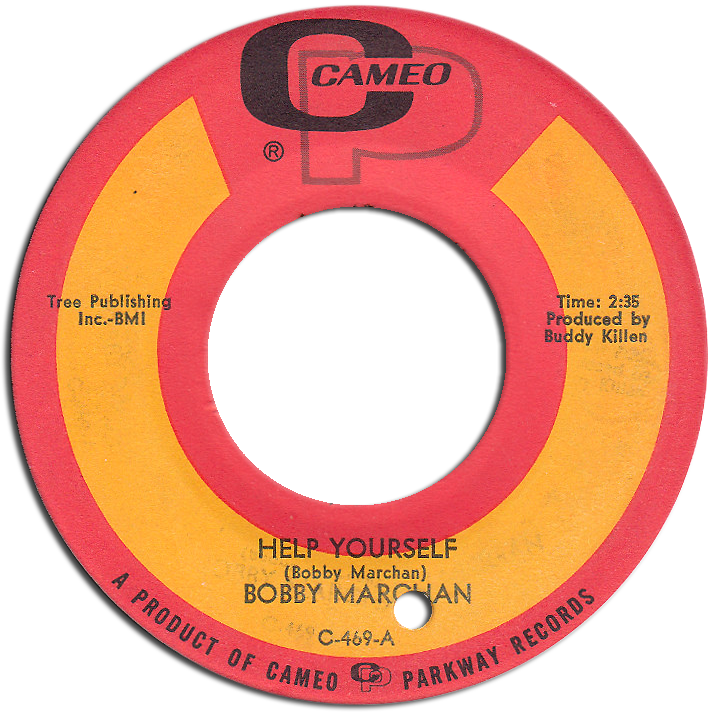
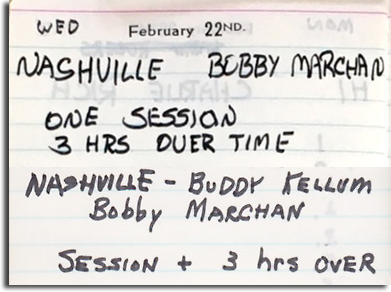
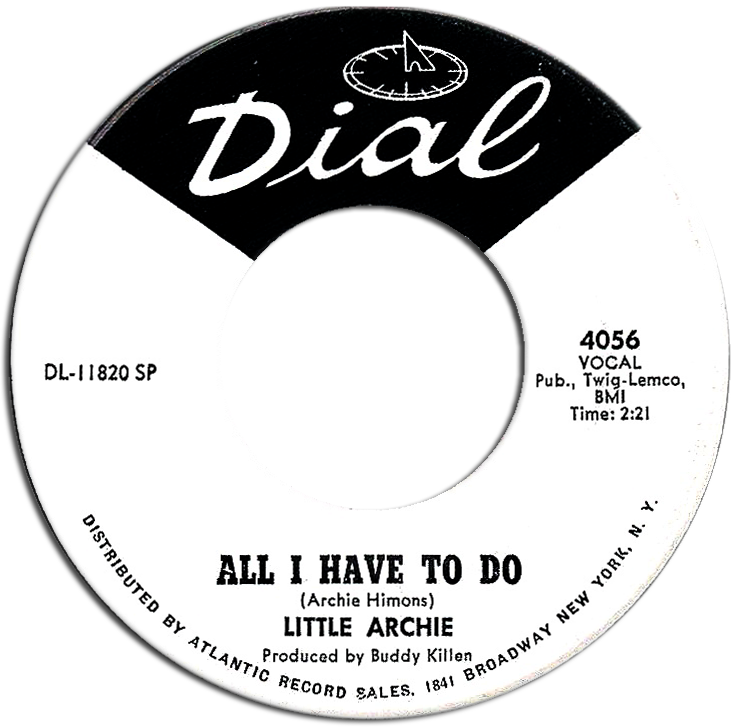 Killen would bring both Reggie and Bobby back to Nashville in February to cut Bobby Marchan's funky Help Yourself for Cameo/Parkway. Although not mentioned by name in either of the log books, we believe that the three hours overtime listed by both of them was used for a Dial session on the man John Ridley calls a 'most eclectic personality,' Little Archie. Released that March, the high energy All I Have To Do represents yet another hidden Nashville R&B gem, cut by the boys from Memphis.
Killen would bring both Reggie and Bobby back to Nashville in February to cut Bobby Marchan's funky Help Yourself for Cameo/Parkway. Although not mentioned by name in either of the log books, we believe that the three hours overtime listed by both of them was used for a Dial session on the man John Ridley calls a 'most eclectic personality,' Little Archie. Released that March, the high energy All I Have To Do represents yet another hidden Nashville R&B gem, cut by the boys from Memphis.
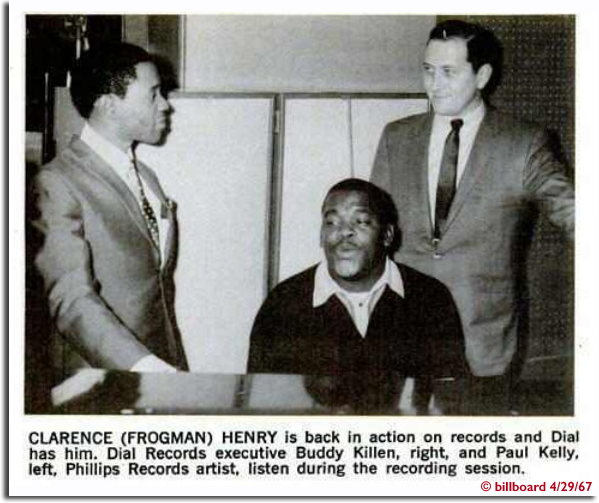 A few weeks later, Killen brought the boys back again to cut Dial's new signee, Clarence 'Frogman' Henry. Lo and behold, there, released as the flip of Tree songwriter Curly Putnam's Hummin' A Heartache, is Moman's This Time!
A few weeks later, Killen brought the boys back again to cut Dial's new signee, Clarence 'Frogman' Henry. Lo and behold, there, released as the flip of Tree songwriter Curly Putnam's Hummin' A Heartache, is Moman's This Time!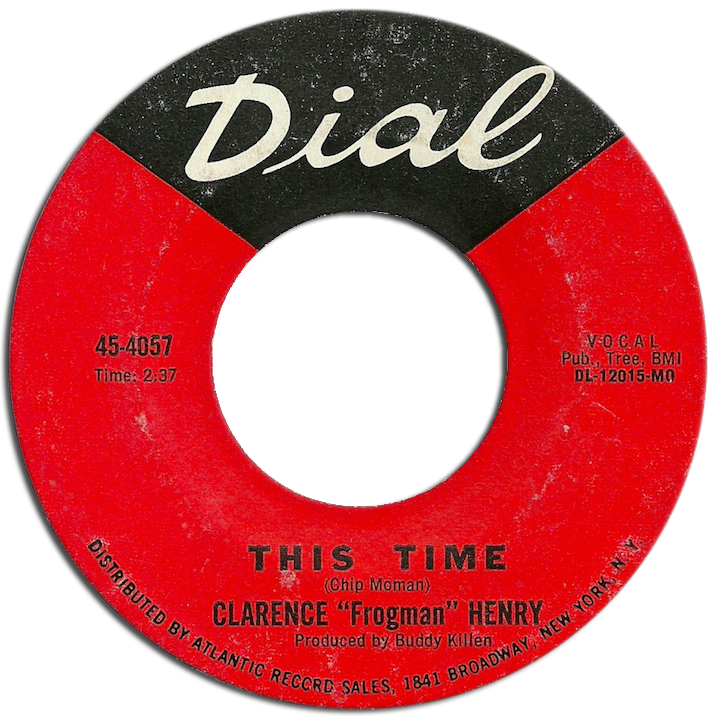 Maybe the best version of the tune to date, I love how Frogman kind of goes off there towards the end. The guitar doesn't really sound like Reggie, and may well have been played by ol' Chips himself. Another favorite from these sessions is Frogman's take on Marchan's Shake Your Money Maker. I'd bet the farm that's Tommy Cogbill on that bass!
Maybe the best version of the tune to date, I love how Frogman kind of goes off there towards the end. The guitar doesn't really sound like Reggie, and may well have been played by ol' Chips himself. Another favorite from these sessions is Frogman's take on Marchan's Shake Your Money Maker. I'd bet the farm that's Tommy Cogbill on that bass!
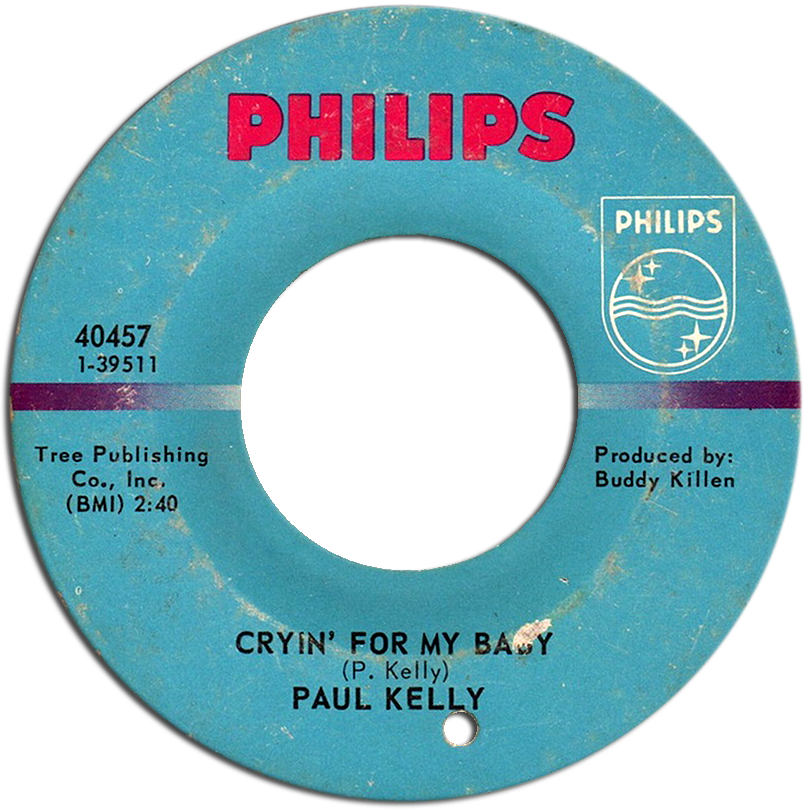 Buddy Killen had picked up Paul Kelly's Chills And Fever from Lloyd, a small Miami label, and released it on Dial in late 1965. Despite Atlantic getting behind the record, it didn't do much. Impressed by his songwriting abilities, Killen signed him and issued one more Dial 45 on him in February of '66 that did even less. By November, Buddy had worked out a deal with Mercury, who (as we'll see)
Buddy Killen had picked up Paul Kelly's Chills And Fever from Lloyd, a small Miami label, and released it on Dial in late 1965. Despite Atlantic getting behind the record, it didn't do much. Impressed by his songwriting abilities, Killen signed him and issued one more Dial 45 on him in February of '66 that did even less. By November, Buddy had worked out a deal with Mercury, who (as we'll see) 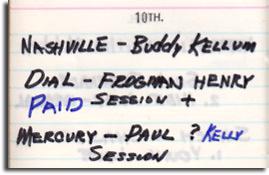 was looking to expand their R&B operations, to license Kelly's records to their Phillips subsidiary. As is obvious from the great Billboard photo above, Killen believed in Kelly (almost as much as he did Joe Tex), and would work closely with him for years. After the Frogman session on March 10th, Killen produced four sides on Paul for Phillips, including the marvelously deep Cryin' For My Baby... wow!.
was looking to expand their R&B operations, to license Kelly's records to their Phillips subsidiary. As is obvious from the great Billboard photo above, Killen believed in Kelly (almost as much as he did Joe Tex), and would work closely with him for years. After the Frogman session on March 10th, Killen produced four sides on Paul for Phillips, including the marvelously deep Cryin' For My Baby... wow!.
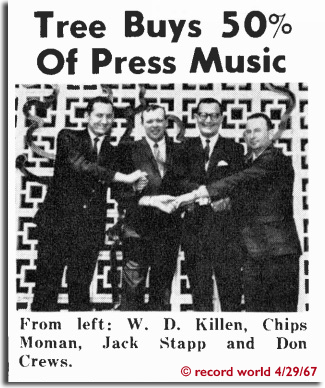 In the issue of Record World that was published the same date as the Billboard mentioned above, it was announced that Tree had purchased a 50% stake in Press Music. With Penn/Moman composition The Dark End Of The Street currently riding the charts, and Do Right Woman, Do Right Man earning Press mechanicals as the flip of Aretha's huge number one hit (before it broke into the R&B top forty on its own), I'm sure Jack Stapp was happy to oblige. Besides managing to get Chips into a suit and tie, the deal would also provide a much needed influx of cash to fund the recent equipment upgrade at American. Don Crews was all smiles, as I'm sure Stapp was later on, as future Press big sellers like Cry Like A Baby and Suspicious Minds were now half theirs.
In the issue of Record World that was published the same date as the Billboard mentioned above, it was announced that Tree had purchased a 50% stake in Press Music. With Penn/Moman composition The Dark End Of The Street currently riding the charts, and Do Right Woman, Do Right Man earning Press mechanicals as the flip of Aretha's huge number one hit (before it broke into the R&B top forty on its own), I'm sure Jack Stapp was happy to oblige. Besides managing to get Chips into a suit and tie, the deal would also provide a much needed influx of cash to fund the recent equipment upgrade at American. Don Crews was all smiles, as I'm sure Stapp was later on, as future Press big sellers like Cry Like A Baby and Suspicious Minds were now half theirs.
With the console at American now up to snuff, and his 'house band' just about where he wanted them, by May of 1967 Chips Moman had decided that from then on, the Mountains would have to come to Mohammed... and they did.
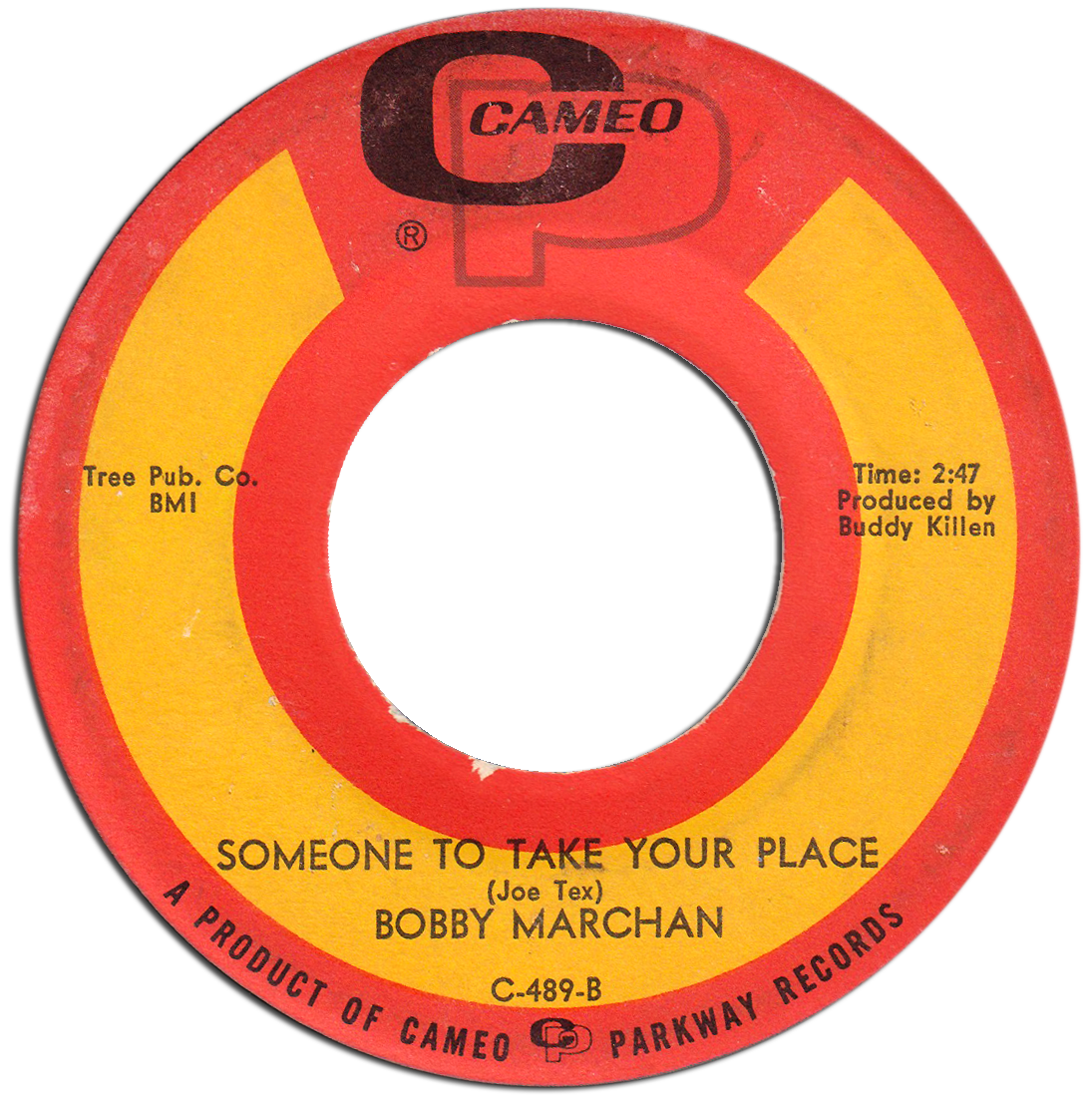 As mentioned earlier, almost the entire month of May had been left blank in Reggie's book, but we had found a
As mentioned earlier, almost the entire month of May had been left blank in Reggie's book, but we had found a 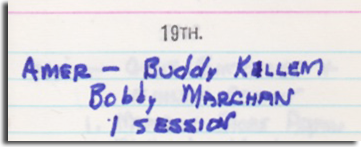 reference in the Cameo /Parkway log sheets (thank you, Teri Landi!) for a session held at American on Bobby Marchan on May 19th, which was subsequently confirmed by an entry in Bobby Emmons' book. One of the absolute greatest records to ever emanate from 827 Thomas Street was cut that day - the Buddy Killen produced Someone To Take Your Place*, which still knocks me out every time I hear it. Check out Reggie's guitar, and Charlie Chalmers wailing on that saxophone! Yeah, Baby! Marchan would also record the way cool New Orleans flavored Sad Sack at American that October.
reference in the Cameo /Parkway log sheets (thank you, Teri Landi!) for a session held at American on Bobby Marchan on May 19th, which was subsequently confirmed by an entry in Bobby Emmons' book. One of the absolute greatest records to ever emanate from 827 Thomas Street was cut that day - the Buddy Killen produced Someone To Take Your Place*, which still knocks me out every time I hear it. Check out Reggie's guitar, and Charlie Chalmers wailing on that saxophone! Yeah, Baby! Marchan would also record the way cool New Orleans flavored Sad Sack at American that October.
 ...as it turns out, however, Marchan's May 19th session may not have been Buddy's first visit to American after all. In the liner notes to a Shout CD Singles A's & B's Volume 2, they refer to a session held on May 8th in 'Tennessee?' which yielded #24 R&B hit Woman Like That, Yeah.
...as it turns out, however, Marchan's May 19th session may not have been Buddy's first visit to American after all. In the liner notes to a Shout CD Singles A's & B's Volume 2, they refer to a session held on May 8th in 'Tennessee?' which yielded #24 R&B hit Woman Like That, Yeah. So, Nashville or Memphis? Well, that's Reggie on there for sure, but according to Bobby's book, Emmons was otherwise engaged, working on demos for eight hours at Pepper for Larry Raspberry. Ultimately, I guess it doesn't matter much. Buddy did indeed bring Joe to American for sure on June 28th, to cut the great A Woman's Hands, which also climbed to #24 R&B in Billboard that Fall. It was Joe's next visit to American in September that has gotten all the press over the years, and rightfully so...
So, Nashville or Memphis? Well, that's Reggie on there for sure, but according to Bobby's book, Emmons was otherwise engaged, working on demos for eight hours at Pepper for Larry Raspberry. Ultimately, I guess it doesn't matter much. Buddy did indeed bring Joe to American for sure on June 28th, to cut the great A Woman's Hands, which also climbed to #24 R&B in Billboard that Fall. It was Joe's next visit to American in September that has gotten all the press over the years, and rightfully so...
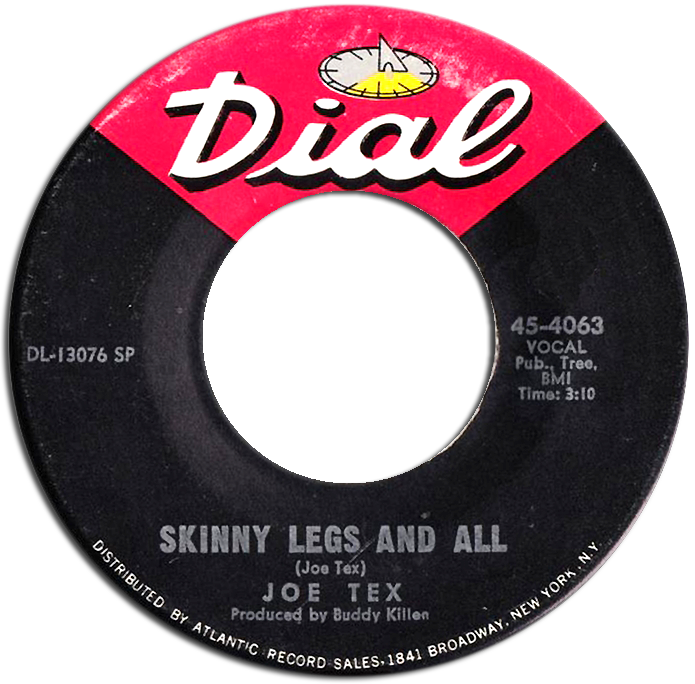 "Reggie was so creative, God, what a guitar player," Killen told John Broven in a 2003 interview, "when he hit that lick on Skinny Legs And All, Joe fell out in the middle of the floor, he started kicking!" In Killen's autobiography he said, "I brought the tape back to
"Reggie was so creative, God, what a guitar player," Killen told John Broven in a 2003 interview, "when he hit that lick on Skinny Legs And All, Joe fell out in the middle of the floor, he started kicking!" In Killen's autobiography he said, "I brought the tape back to 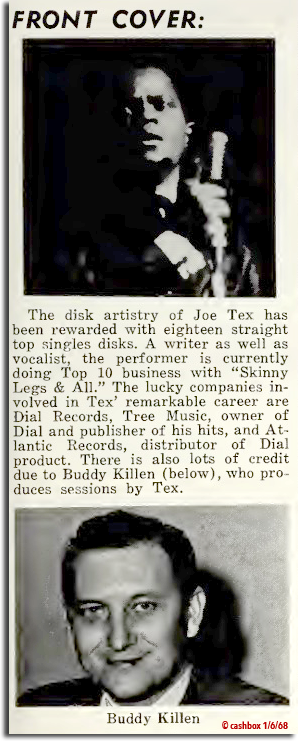 Nashville and listened to it a number of times. I felt that it still needed something..." It was Jerry Wexler who gave him the idea of dubbing in an audience to make it sound like a live recording. "The studio held only thirty people, not enough to sound like an auditorium crowd, so we overdubbed the applause more than once," Buddy goes on to say, "...I also added slapback reverb to the tape, so it sounded as if the music was bouncing off the walls of the auditorium." The idea worked, and 'Skinny Legs' went straight into the Pop top ten in both Billboard and Cash Box, and spent an incredible four months on the R&B charts, including two weeks at #2 (only kept from the top slot by I Heard It Through The Grapevine), on its way to becoming the all-time classic it remains to this day. It was Joe Tex's 18th chart appearance in a row, a feat which would put him on the front cover of Cash Box in early 1968. I guess there's not much else to say that hasn't already been written about this record, except that I'd like to point out something I had been able to confirm with Darryl Carter, who was there in the room - it is Bobby Womack who asks Joe why he doesn't take that woman with the skinny legs...
Nashville and listened to it a number of times. I felt that it still needed something..." It was Jerry Wexler who gave him the idea of dubbing in an audience to make it sound like a live recording. "The studio held only thirty people, not enough to sound like an auditorium crowd, so we overdubbed the applause more than once," Buddy goes on to say, "...I also added slapback reverb to the tape, so it sounded as if the music was bouncing off the walls of the auditorium." The idea worked, and 'Skinny Legs' went straight into the Pop top ten in both Billboard and Cash Box, and spent an incredible four months on the R&B charts, including two weeks at #2 (only kept from the top slot by I Heard It Through The Grapevine), on its way to becoming the all-time classic it remains to this day. It was Joe Tex's 18th chart appearance in a row, a feat which would put him on the front cover of Cash Box in early 1968. I guess there's not much else to say that hasn't already been written about this record, except that I'd like to point out something I had been able to confirm with Darryl Carter, who was there in the room - it is Bobby Womack who asks Joe why he doesn't take that woman with the skinny legs...
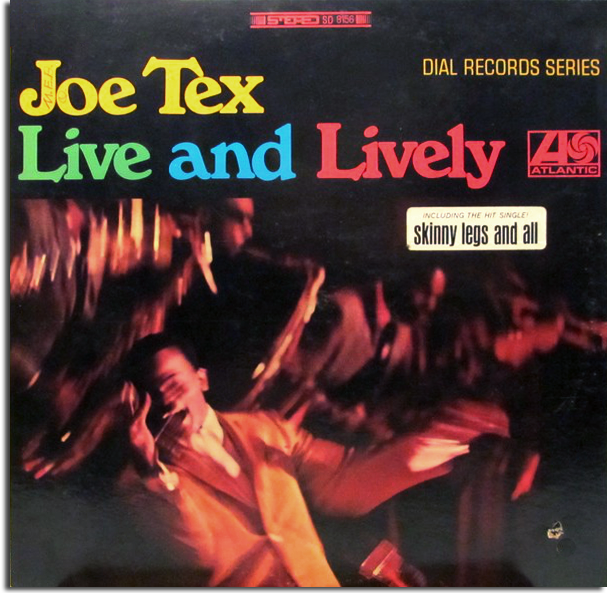 In a definite case of less probably having been more, the unparalleled success of that single convinced Atlantic to record a whole album with that 'live in the studio' concept. On Live And Lively, released in early 1968, Killen overdubbed audience sounds over Joe's previous three hits as well, and held sessions in Nashville with Tex's own band on November 2nd to flesh out the LP. There is one track listed as having been cut at those sessions, however, that we believe has Reggie
In a definite case of less probably having been more, the unparalleled success of that single convinced Atlantic to record a whole album with that 'live in the studio' concept. On Live And Lively, released in early 1968, Killen overdubbed audience sounds over Joe's previous three hits as well, and held sessions in Nashville with Tex's own band on November 2nd to flesh out the LP. There is one track listed as having been cut at those sessions, however, that we believe has Reggie playing on it, his deep reading of Do Right Woman, Do Right Man. That guitar may have also been an overdub, as Buddy would bring Joe to American one more time a week later to cut his timeless holiday classic, I'll Make Every Day Christmas (For My Woman). Buddy had also brought Paul Kelly along with him on that visit, and cut the great My Love Is Growing Stronger the following day.
playing on it, his deep reading of Do Right Woman, Do Right Man. That guitar may have also been an overdub, as Buddy would bring Joe to American one more time a week later to cut his timeless holiday classic, I'll Make Every Day Christmas (For My Woman). Buddy had also brought Paul Kelly along with him on that visit, and cut the great My Love Is Growing Stronger the following day.
That's about it for Buddy Killen's 1967 involvement with Reggie and/or Bobby Emmons, but there is one more Dial release we need to talk about...
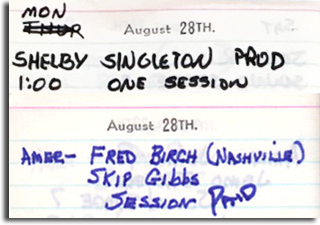 An entry in Reggie's book for a session on August 28th for Shelby Singleton Productions had us scratching our heads, and coming up blank. Singleton had left Mercury earlier in 1967, and started up his own SSS International label, but we couldn't seem to connect the dots on any of those releases. Once we were able to compare Bobby's entry for that date, however, we were able to figure it out... well almost, anyway.
An entry in Reggie's book for a session on August 28th for Shelby Singleton Productions had us scratching our heads, and coming up blank. Singleton had left Mercury earlier in 1967, and started up his own SSS International label, but we couldn't seem to connect the dots on any of those releases. Once we were able to compare Bobby's entry for that date, however, we were able to figure it out... well almost, anyway.
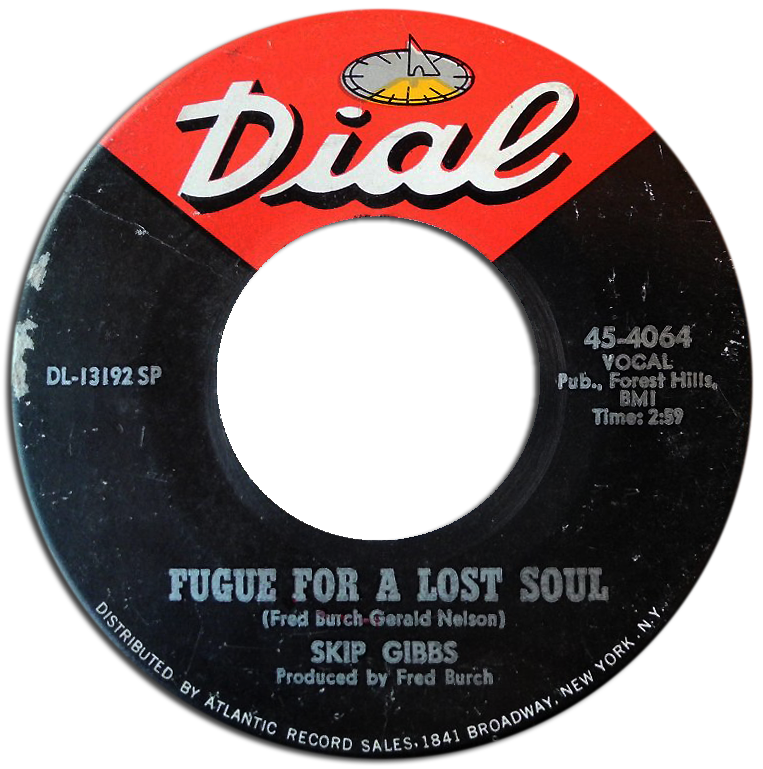 Apparently Skip Gibbs first recording, the snappy upbeat arrangement here on Fugue For A Lost Soul belies its title, and it's dark subject matter (which, despite repeated listenings I have yet to figure out). Gibbs would go on to have five releases on Shelby Singleton's
Apparently Skip Gibbs first recording, the snappy upbeat arrangement here on Fugue For A Lost Soul belies its title, and it's dark subject matter (which, despite repeated listenings I have yet to figure out). Gibbs would go on to have five releases on Shelby Singleton's 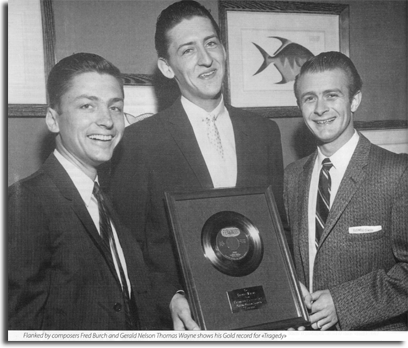 Plantation label later on, so there's that connection... but (just when you thought we were done with all that 'Wayne's World' stuff we were talking about earlier), it turns out that the composers of this little gem were none other than the same Fred Burch and Gerald Nelson who wrote 'Tragedy' for Thomas Wayne back in 1958... You really can't make this stuff up! Burch also produced, and would go on to work with Singleton as a songwriter (including writing the awesome He Made A Woman Out Of Me for Betty Lavette on Silver Fox), so how on earth this 45 ended up on Dial is anybody's guess...
Plantation label later on, so there's that connection... but (just when you thought we were done with all that 'Wayne's World' stuff we were talking about earlier), it turns out that the composers of this little gem were none other than the same Fred Burch and Gerald Nelson who wrote 'Tragedy' for Thomas Wayne back in 1958... You really can't make this stuff up! Burch also produced, and would go on to work with Singleton as a songwriter (including writing the awesome He Made A Woman Out Of Me for Betty Lavette on Silver Fox), so how on earth this 45 ended up on Dial is anybody's guess...
Shelby Singleton himself apparently did show up at American on September 17th to co-produce one of the great lost Soul records with Finley Duncan. Duncan had started up his Minaret label in 1962, but had also produced singles by Len Wade and The Tikis for Dial at Fame in 1966. Singleton had apparently bought an interest in Minaret shortly after that.
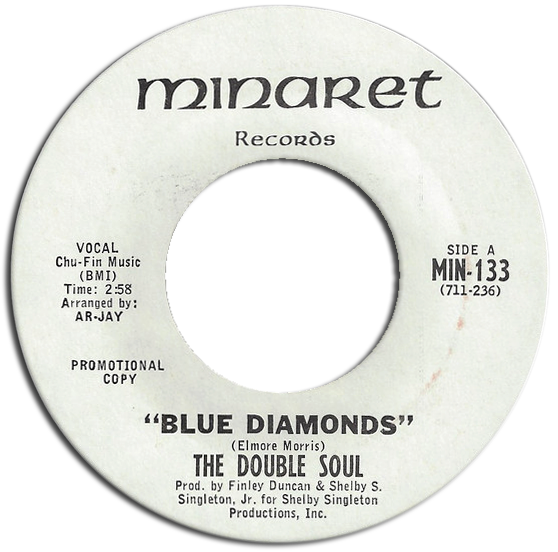 According to Sir Shambling, The Double Soul was made up of Elmore Morris and Charles Cooper. Morris was an R&B veteran who had cut a number of sides for Peacock in
According to Sir Shambling, The Double Soul was made up of Elmore Morris and Charles Cooper. Morris was an R&B veteran who had cut a number of sides for Peacock in 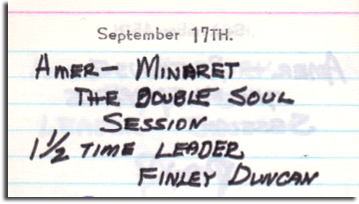 the late 50s. Cooper would later make up half of another duo Finley put together for the Abet label, Chuck & Mariann. Written by Morris, Blue Diamonds was selected as the A side of their lone 45, although the other two tunes cut that day (available on the discography page) are just as good. At this point, Singleton was still about a year away from hitting the big time with Harper Valley P.T.A., after which he and Duncan would build their Playground Recording Studio in Valparaiso, Florida.
the late 50s. Cooper would later make up half of another duo Finley put together for the Abet label, Chuck & Mariann. Written by Morris, Blue Diamonds was selected as the A side of their lone 45, although the other two tunes cut that day (available on the discography page) are just as good. At this point, Singleton was still about a year away from hitting the big time with Harper Valley P.T.A., after which he and Duncan would build their Playground Recording Studio in Valparaiso, Florida.
*also available on ACE CDHCD 1572 The Soul Of The Memphis Boys
Special thanks go to Mark Nicholson, John Broven, John Ridley, Jay Halsey, Teri Landi and Russ Wapensky.
We continue our discussion of the incredible body of work that Reggie Young and Bobby Emmons created together in 1967 in episode three, just click on the link below. It's also over on Soul Sauce... but don't forget the other 450 or so tracks that are always available on our discography page! Thanks for tuning in!
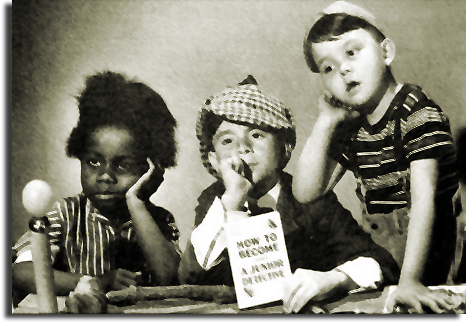


"Any freakin' thing is possible..."
In his comments after I posted 1967 episode one here, Peter Nickols went on to say: "...surely Al Gardner's 'Just The Touch Of Your Hand' is also superb... Don demoed that too. I know you feature the Gardner side in your audio samples but I think it's worth a text mention - just my opinion." Hmmm... I thought about that a while, then I remembered why I had decided not to 'text mention it' in the first place:
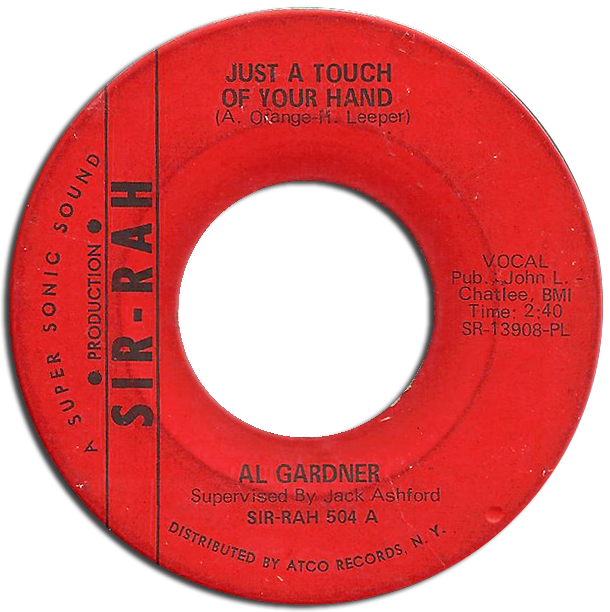 Although I totally agree with Peter's assessment that Just A Touch Of Your Hand is a superb record, with Reggie Young's guitar all over it, there is no mention of Willie Mitchell on the label... as a matter of fact, the label says 'Supervised by Jack Ashford'... Huh? Like Motown Tambourine playing Funk Brother Jack Ashford? This obviously would place this as a Detroit production and, although it had been included on the Northern Souljers CD as being cut with Willie in Memphis, I figured I'd have trouble connecting those dots, and so I left it alone.
Although I totally agree with Peter's assessment that Just A Touch Of Your Hand is a superb record, with Reggie Young's guitar all over it, there is no mention of Willie Mitchell on the label... as a matter of fact, the label says 'Supervised by Jack Ashford'... Huh? Like Motown Tambourine playing Funk Brother Jack Ashford? This obviously would place this as a Detroit production and, although it had been included on the Northern Souljers CD as being cut with Willie in Memphis, I figured I'd have trouble connecting those dots, and so I left it alone.
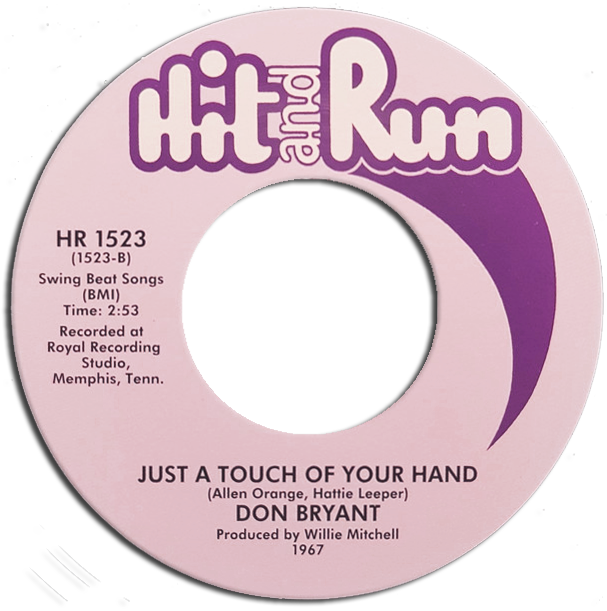 As Nickols mentioned, Don Bryant had also cut a demo version of Just A Touch Of Your Hand - a version so good it was released as a 45 (backed with Don's equally awesome demo of Cloudy Days mentioned earlier) on Garry Cape's Hit and Run label just last year. Unhindered by the syrupy strings and Motor City echo chamber of the Ashford supervised release, Don delivers the goods over what appears to be the same backing track. Wow! Bryant's resurgence as one of the greatest living Soul singers still out there doing it has earned him a Grammy nomination for his excellent 2020 album You Make Me Feel. With The Grammys less than a week away, my friend (and producer of that record) Scott Bomar still took time out to ask Don if he could recall any details about how it is he cut this demo of somebody else's song at Hi: "Unfortunately he didn't recall any details about how the song came to him," Scott said, "...Willie was handling everything."
As Nickols mentioned, Don Bryant had also cut a demo version of Just A Touch Of Your Hand - a version so good it was released as a 45 (backed with Don's equally awesome demo of Cloudy Days mentioned earlier) on Garry Cape's Hit and Run label just last year. Unhindered by the syrupy strings and Motor City echo chamber of the Ashford supervised release, Don delivers the goods over what appears to be the same backing track. Wow! Bryant's resurgence as one of the greatest living Soul singers still out there doing it has earned him a Grammy nomination for his excellent 2020 album You Make Me Feel. With The Grammys less than a week away, my friend (and producer of that record) Scott Bomar still took time out to ask Don if he could recall any details about how it is he cut this demo of somebody else's song at Hi: "Unfortunately he didn't recall any details about how the song came to him," Scott said, "...Willie was handling everything."
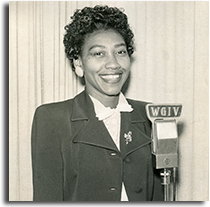 Hmmm... maybe the names of the songwriters might offer us a clue? I had no idea who 'H. Leeper' might be, until Nickols put me on her trail: "that's a fairly unusual name and I think it is probably the influential North Carolina DJ known locally in Charlotte as Chatty Hattie Leeper." Like Martha Jean the Queen, Hattie was one of the first female R&B disk jockeys in the South, with a loyal following over 16,000 watt WGIV in Charlotte. It was through her position as secretary of the National Association of Radio and Television Announcers, however, that she also maintained close contacts with most of the major players in the mid-sixties Soul scene... more on that in a minute.
Hmmm... maybe the names of the songwriters might offer us a clue? I had no idea who 'H. Leeper' might be, until Nickols put me on her trail: "that's a fairly unusual name and I think it is probably the influential North Carolina DJ known locally in Charlotte as Chatty Hattie Leeper." Like Martha Jean the Queen, Hattie was one of the first female R&B disk jockeys in the South, with a loyal following over 16,000 watt WGIV in Charlotte. It was through her position as secretary of the National Association of Radio and Television Announcers, however, that she also maintained close contacts with most of the major players in the mid-sixties Soul scene... more on that in a minute.
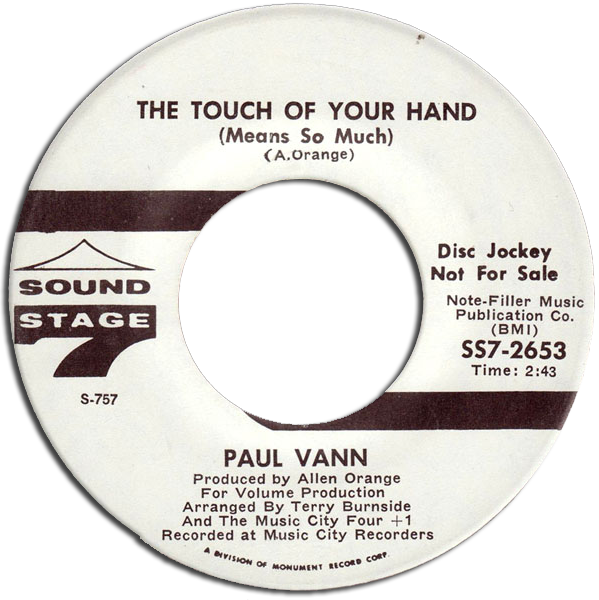
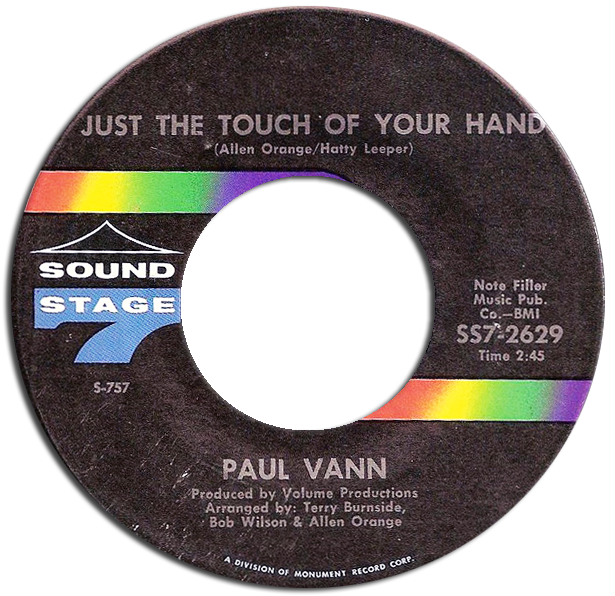 The other songwriter listed on the label was Allen Orange. The subject of our exhaustive Soul Detective Case Five (the case which would lead to our re-discovery of Sir Lattimore Brown), it didn't seem possible that I hadn't come across Hattie's name before. Sound Stage 7 had released Paul Vann's cover of the song as The Touch Of Your Hand (Means So Much) in February of 1970, with Orange listed as the sole composer. This is the version that we featured on the site back in 2007. What I hadn't realized at the time was that SS7 had also issued it as Just The Touch Of Your Hand the year before, where 'Hatty' had also been given credit on the label. I still cant decide if they are both the same recordings...
The other songwriter listed on the label was Allen Orange. The subject of our exhaustive Soul Detective Case Five (the case which would lead to our re-discovery of Sir Lattimore Brown), it didn't seem possible that I hadn't come across Hattie's name before. Sound Stage 7 had released Paul Vann's cover of the song as The Touch Of Your Hand (Means So Much) in February of 1970, with Orange listed as the sole composer. This is the version that we featured on the site back in 2007. What I hadn't realized at the time was that SS7 had also issued it as Just The Touch Of Your Hand the year before, where 'Hatty' had also been given credit on the label. I still cant decide if they are both the same recordings...
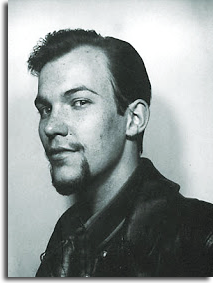 In 1967, Orange was already working with John R at Sound Stage 7 alongside Bob Wilson in Nashville. How was it that this song had been recorded in Memphis via Detroit (and North Carolina) a full two years before the SS7 versions? Wilson had started out in Motor City with Ed Wingate at Golden World/Ric Tic before hiring on in Music City with Richbourg at Monument/SS7. It was through the aforementioned Case Five that I got to meet and hang out with him and do some amazing things (like cutting Sir Lattimore with him at Royal Studio in Memphis in 2008). Although we hadn't spoken for a while, I figured I'd ask him: "I am on the Paul Vann cut, and have label credit as arranger, with Terry Burnside (Cincinnatti, white fellow, King Records background)... when we were with Willie, I don't recall if I spoke of my background in Detroit, at Ric Tic, or not. I know he was very aware of my Sound Stage 7/Joe Simon/John R connection, but, don't recall discussing Detroit. I never heard Willie Mitchell's name spoken in Detroit, but, as you know, any freakin' thing is possible..." It sure is.
In 1967, Orange was already working with John R at Sound Stage 7 alongside Bob Wilson in Nashville. How was it that this song had been recorded in Memphis via Detroit (and North Carolina) a full two years before the SS7 versions? Wilson had started out in Motor City with Ed Wingate at Golden World/Ric Tic before hiring on in Music City with Richbourg at Monument/SS7. It was through the aforementioned Case Five that I got to meet and hang out with him and do some amazing things (like cutting Sir Lattimore with him at Royal Studio in Memphis in 2008). Although we hadn't spoken for a while, I figured I'd ask him: "I am on the Paul Vann cut, and have label credit as arranger, with Terry Burnside (Cincinnatti, white fellow, King Records background)... when we were with Willie, I don't recall if I spoke of my background in Detroit, at Ric Tic, or not. I know he was very aware of my Sound Stage 7/Joe Simon/John R connection, but, don't recall discussing Detroit. I never heard Willie Mitchell's name spoken in Detroit, but, as you know, any freakin' thing is possible..." It sure is.
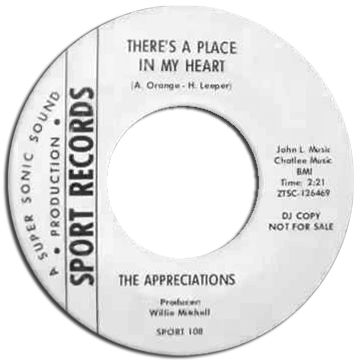 There's A Place In My Heart is another Allen Orange/Hattie Leeper song that was produced by Willie Mitchell at those sessions in Memphis in July of 1967 on a vocal group called The Appreciations. It appears once again that the same backing track was used as on the Don Bryant demo. In Mark Windle's book, It's Better To Cry, there is an in-depth portrait of The Appreciations based on extensive interviews with several members of the group. They first got together as students at Johnson C. Smith University in Charlotte, North Carolina where they came to the attention of Chatty Hattie, who would become their manager and biggest advocate. After arranging a session with Jerry Wexler in New York for Atlantic that somehow ended up on Jubilee, Leeper set her sights on Detroit.
There's A Place In My Heart is another Allen Orange/Hattie Leeper song that was produced by Willie Mitchell at those sessions in Memphis in July of 1967 on a vocal group called The Appreciations. It appears once again that the same backing track was used as on the Don Bryant demo. In Mark Windle's book, It's Better To Cry, there is an in-depth portrait of The Appreciations based on extensive interviews with several members of the group. They first got together as students at Johnson C. Smith University in Charlotte, North Carolina where they came to the attention of Chatty Hattie, who would become their manager and biggest advocate. After arranging a session with Jerry Wexler in New York for Atlantic that somehow ended up on Jubilee, Leeper set her sights on Detroit.
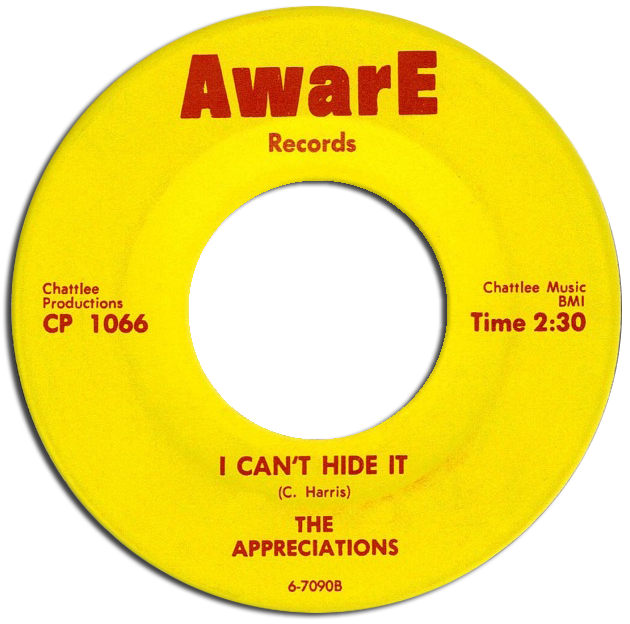 According to Windle: "Their next recording was I Can't Hide It / No, No, No (Aware 1066). Hattie set up Aware for this sole release. The tracks were recorded in 1966 at the Golden World / Ric Tic Records Studios in Detroit. The group liked the Motown sound and wanted to be part of it. Willie Mitchell (band leader, producer, wind and keyboard player) coached and arranged the session and, according to Charles, played baritone sax. Mitchell is perhaps more associated with Memphis than Detroit. In reality however he wrote, produced, arranged and recorded a number of tracks for Lee Rogers, Buddy Lamp and others on Detroit labels such as Wheelsville, Premium Stuff and D-Town, either from his Memphis base or in Detroit itself." Whoah... wait a minute - this is the first I've heard about Willie actually recording in Detroit! Windle goes on to explain ..."the lead singer was adamant it was Willie. I questioned him two or three times to double check, as obviously I knew this would be an issue." The baritone sax solo certainly sounds like Motown stalwart Mike Terry, but when asked years later, Terry said it wasn't him. I suppose, if Willie actually was there at Golden World, his late great brother James, who was a killer baritone man in his own right, would probably have been there as well... like Wilson said "...any freakin' thing is possible." We may never know for sure, but that would certainly explain his connection with Hattie Leeper.
According to Windle: "Their next recording was I Can't Hide It / No, No, No (Aware 1066). Hattie set up Aware for this sole release. The tracks were recorded in 1966 at the Golden World / Ric Tic Records Studios in Detroit. The group liked the Motown sound and wanted to be part of it. Willie Mitchell (band leader, producer, wind and keyboard player) coached and arranged the session and, according to Charles, played baritone sax. Mitchell is perhaps more associated with Memphis than Detroit. In reality however he wrote, produced, arranged and recorded a number of tracks for Lee Rogers, Buddy Lamp and others on Detroit labels such as Wheelsville, Premium Stuff and D-Town, either from his Memphis base or in Detroit itself." Whoah... wait a minute - this is the first I've heard about Willie actually recording in Detroit! Windle goes on to explain ..."the lead singer was adamant it was Willie. I questioned him two or three times to double check, as obviously I knew this would be an issue." The baritone sax solo certainly sounds like Motown stalwart Mike Terry, but when asked years later, Terry said it wasn't him. I suppose, if Willie actually was there at Golden World, his late great brother James, who was a killer baritone man in his own right, would probably have been there as well... like Wilson said "...any freakin' thing is possible." We may never know for sure, but that would certainly explain his connection with Hattie Leeper.
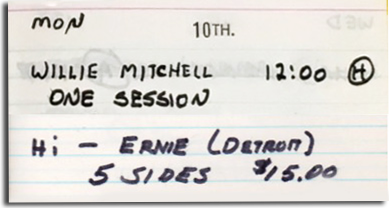 But what about our hypothesis last time out that it was another disk jockey, Detroit's Ernie Durham, that cut those Sport and Sir-Rah tracks with Willie in Memphis? Perhaps the key to understanding all this lies in Stuart Cosgrove's excellent Detroit 67: The Year That Changed Soul
But what about our hypothesis last time out that it was another disk jockey, Detroit's Ernie Durham, that cut those Sport and Sir-Rah tracks with Willie in Memphis? Perhaps the key to understanding all this lies in Stuart Cosgrove's excellent Detroit 67: The Year That Changed Soul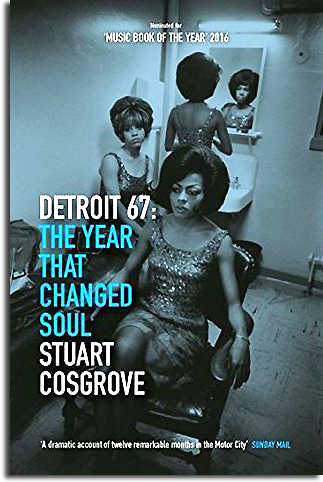 where he writes: "By 1967 Frantic Eddie Durham's power was in decline and the old R&B radio station era he had come to personify was hanging on for dear life... the radio personalities that had inspired Gordy as a teenager... were losing their grip on power." Although it may not have seemed like it, Motown had begun to lose its grip as well, despite purchasing the Golden World studios shortly after the Aware sessions outlined above. Mickey Stevenson had abruptly left the company in early 1967, and people began to get the message that all was not well in Hitsville U.S.A.
where he writes: "By 1967 Frantic Eddie Durham's power was in decline and the old R&B radio station era he had come to personify was hanging on for dear life... the radio personalities that had inspired Gordy as a teenager... were losing their grip on power." Although it may not have seemed like it, Motown had begun to lose its grip as well, despite purchasing the Golden World studios shortly after the Aware sessions outlined above. Mickey Stevenson had abruptly left the company in early 1967, and people began to get the message that all was not well in Hitsville U.S.A.
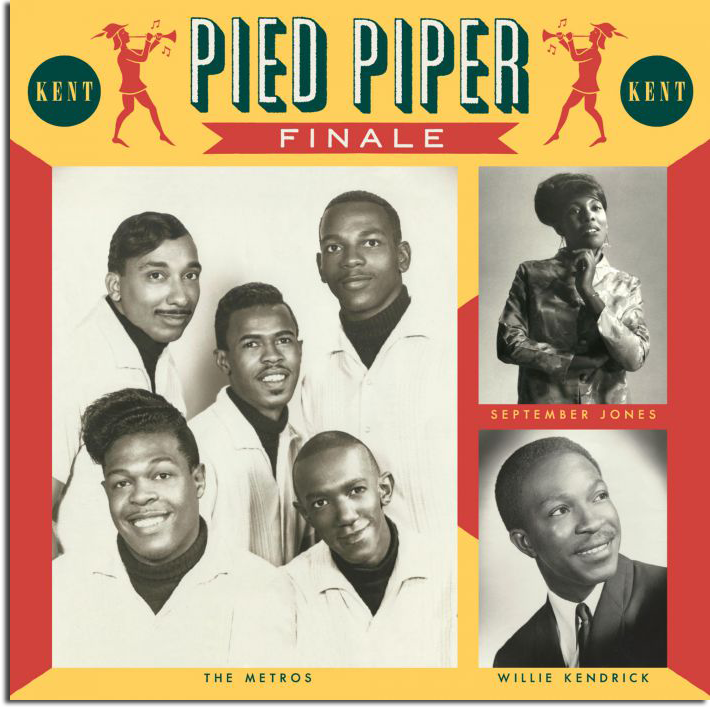 Sensing that vulnerability, a Detroit big shot named Andrew Harris started up his own trio of labels (Boss, Sport and Sir-Rah), hiring some of the biggest names in Detroit in the process, like Andre Williams, Shelley Haims and the aforementioned Jack Ashford. According to Ady Croasdell's liner notes to the Kent CD Pied Piper Finale, "Harris is remembered by Ashford as a wealthy older guy who wanted to get involved in records, and by Jay Johnson of The Four Sonics as a red-haired white guy who was reputed to have earned his fortune through gambling. Ashford's initial meeting with him was notable for being the first time he had seen a $500 bill when Harris peeled one from a wad to cover expenses..." It's certainly not much of a stretch to think that he might have peeled a few of those off and sent them in Frantic Ernie's direction to cover those sessions in Memphis... "...any freakin' thing is possible."
Sensing that vulnerability, a Detroit big shot named Andrew Harris started up his own trio of labels (Boss, Sport and Sir-Rah), hiring some of the biggest names in Detroit in the process, like Andre Williams, Shelley Haims and the aforementioned Jack Ashford. According to Ady Croasdell's liner notes to the Kent CD Pied Piper Finale, "Harris is remembered by Ashford as a wealthy older guy who wanted to get involved in records, and by Jay Johnson of The Four Sonics as a red-haired white guy who was reputed to have earned his fortune through gambling. Ashford's initial meeting with him was notable for being the first time he had seen a $500 bill when Harris peeled one from a wad to cover expenses..." It's certainly not much of a stretch to think that he might have peeled a few of those off and sent them in Frantic Ernie's direction to cover those sessions in Memphis... "...any freakin' thing is possible."
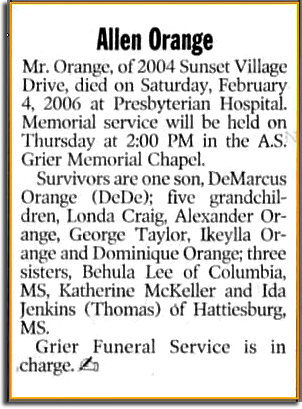 Hmmm... but what about Allen Orange's collaboration with Hattie Leeper? Initially I thought that perhaps Orange had accompanied John R and Joe Simon to Royal Studio in March (more on those sessions soon), and somehow made the connection there. Then I remembered what Aaron Varnell had told Bob Wilson and I when we met with him in Nashville during our Case Five investigation all those years ago - that Allen had gone to live with relatives in North Carolina. It was Garry Cape who then told us he had met with Allen at an assisted living facility in Nashville in 2004, but the next time he tried to contact him they said he had moved out to be with relatives, and they were not at liberty to tell him where that was. All of that led to our discovery of this Death Notice in The Charlotte Observer from 2006, that would be Charlotte, North Carolina, Ms. Leeper's home town. Although at this point it's 'purely conjecture', I can't help but think they had known each other 'back in the day' and had written these songs together way before any of this happened.
Hmmm... but what about Allen Orange's collaboration with Hattie Leeper? Initially I thought that perhaps Orange had accompanied John R and Joe Simon to Royal Studio in March (more on those sessions soon), and somehow made the connection there. Then I remembered what Aaron Varnell had told Bob Wilson and I when we met with him in Nashville during our Case Five investigation all those years ago - that Allen had gone to live with relatives in North Carolina. It was Garry Cape who then told us he had met with Allen at an assisted living facility in Nashville in 2004, but the next time he tried to contact him they said he had moved out to be with relatives, and they were not at liberty to tell him where that was. All of that led to our discovery of this Death Notice in The Charlotte Observer from 2006, that would be Charlotte, North Carolina, Ms. Leeper's home town. Although at this point it's 'purely conjecture', I can't help but think they had known each other 'back in the day' and had written these songs together way before any of this happened.
Im attempting to reach Orange's son, DeMarcus, who had contacted us during our initial investigation, to ask him about all this... stay tuned!
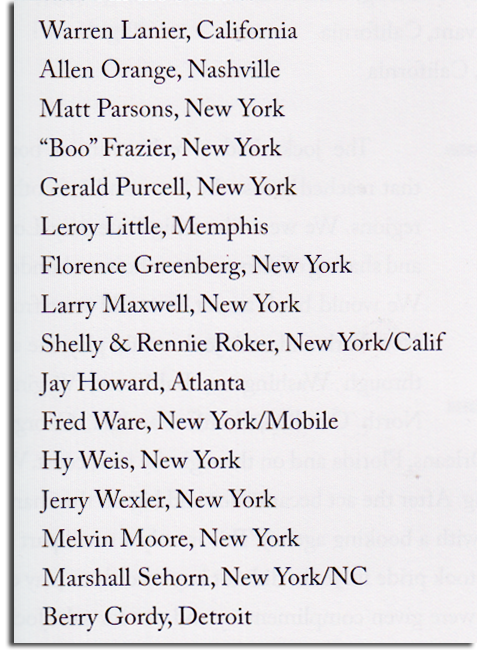 UPDATE: I went out and bought us a copy of Chatty Hatty The Legend, the autobiography, in hopes of shedding some light on all of this. Although she mentions her Chatlee publishing company, she doesn't seem to talk much about her songwriting. In her chapter on managing The Appreciations, neither of the songs in question are listed. She does go on to say "I must mention these good associates as we had record deals and were in constant communication in the business," then goes on to list thirty one names in no apparent order, other than her own estimation of their significance, I suppose. Our man Allen Orange is the second name on the list (although his location is given as Nashville, which makes sense). The only person mentioned in Detroit is Berry Gordy, and the only one from Memphis is Leroy Little. Not much help in this case, I'm afraid, but still fascinating to see the names of all these movers & shakers in the industry, from Jerry Wexler and Florence Greenberg to Marshall Sehorn and Hy Weiss. As Hatty says herself, "I was BIG!"
UPDATE: I went out and bought us a copy of Chatty Hatty The Legend, the autobiography, in hopes of shedding some light on all of this. Although she mentions her Chatlee publishing company, she doesn't seem to talk much about her songwriting. In her chapter on managing The Appreciations, neither of the songs in question are listed. She does go on to say "I must mention these good associates as we had record deals and were in constant communication in the business," then goes on to list thirty one names in no apparent order, other than her own estimation of their significance, I suppose. Our man Allen Orange is the second name on the list (although his location is given as Nashville, which makes sense). The only person mentioned in Detroit is Berry Gordy, and the only one from Memphis is Leroy Little. Not much help in this case, I'm afraid, but still fascinating to see the names of all these movers & shakers in the industry, from Jerry Wexler and Florence Greenberg to Marshall Sehorn and Hy Weiss. As Hatty says herself, "I was BIG!"
Special thanks to Don Bryant, Scott Bomar, Bob Wilson, Mark Windle, Garry Cape, Peter Nickols and Mark Nicholson, without whom this post would not have been possible.
- red kelly, March 2021

_______________________________________

_______________________________________
 _______________________________________
_______________________________________

 _______________________________________
_______________________________________

_______________________________________


